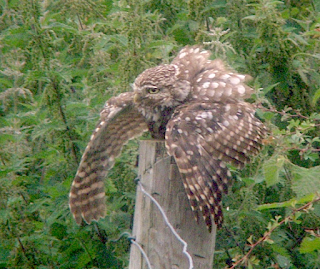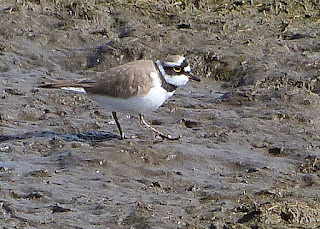Well, it's certainly been an interesting few days!
On Friday, shortly before I was due to catch my train to Oakham for the Birdfair a juvenile
purple heron was discovered in front of the Grisedale Hide at Leighton Moss. Now, given that the last purple heron at the reserve (and in this area) was back in 1996 (I saw that one too) this was not a bird to be missed.
So, I duly legged it up the Skytower - following intel from Kev Kelly that it had flow into reeds 'behind Lilian's' - and scanned the vista. Kev decided to join me as it was no longer visible from the hide and we had no idea what it was going to do next.
 |
| Purple heron (not the Leighton Moss one...) |
After a few gruelling minutes the heron rose from the reeds and flew a short distance before pitching down, out of sight once more. It did this a couple more times before relocating to Grisedale, much to the delight of visiting birders who had hot-tailed it to the reserve in the hope of seeing the rarity.
As I write, it's still present and has shown exceedingly well for many admirers over the past 3 days. I hope to get better views and couple of record shots when I get back to work... in the meantime here's an adult purple heron I photographed elsewhere, previously. All being well, I'll have a pic of the Leighton bird here soon!
Birdfair was fun, as always. I spent all of Saturday and Sunday on the RSPB stand, catching up with old faces and meeting lots of new ones.
Among the book signings hosted on our stand, we had Bill Oddie join us on Saturday afternoon.
 |
| Goodie & Baddie |
I couldn't resist taking the opportunity to have a pic with him; the last time I'd done this was several years ago when I interviewed him in Morecambe for The Visitor newspaper. I expect I remember that occasion more than he does.
Back in North Lancs, I had a mooch around the patch this morning.
Freeman's Pools was a bit livelier than it has been lately with the first notable returning wildfowl; 9
gadwall and a pair of
tufted duck. The usual
little grebes,
coots and
moorhens were present.
Frog Pond and Darter Pool were quiet. Water levels still being high at the Wildfowlers' Pools, there was little on offer beyond a few
mallard. A small number of
teal were snoozing near Reedy Corner.
A group of 6
snipe flew over and the tell-tale calls of a
green sandpiper were audible though I couldn't see the bird.
A check of the Flood failed to reveal the anticipated sandpiper, just 2
little egrets were picking around the muddy pool.
Yet more egrets were out on Aldcliffe Marsh. It's pretty normal these days to be able to stand in one spot and casually count up to 30 egrets...
With the tide at its peak, the river's edge was punctuated with roosting and feeding
redshanks,
lapwings,
curlew and
gulls. Scanning through the birds, I found a couple of
Mediterranean gulls (adult & 2nd winter) and a
common sandpiper but nothing else.
Out on the river there was a group of 10
goosander and 18
cormorants.
 |
| Collared greylags |
The number of
greylag and
Canada geese have been steadily building in recent weeks but today was the first time I've had the opportunity (and inclination) to read any collars. I suppose it gives me something to do on those slow winter days!
Kestrels appear to have had a pretty good season locally (for a change) with up to 6 different birds seen in the area today. They've presumably taken full advantage of the good vole year - I hear that
short-eared and
barn owls have enjoyed high productivity in the county this year. Hopefully we'll see some on the patch this autumn and winter?
On my way home I spotted the green sandpiper as it flew noisily onto the Flood.
After a spot of lunch I had a walk through the FAUNA reserve and had a look at the
little owls. Just two were visible today. The cut arable was filled with birds -
lesser black-back gulls,
herring gulls,
black-headed gulls and one each of
common and
Mediterranean gulls (the latter and adult with a limp) were feeding alongside
jackdaws,
carrion crows and 7
rooks. Surprisingly, I couldn't find any
stock doves among the mass of
wood pigeons and
feral pigeons.
Jon









































